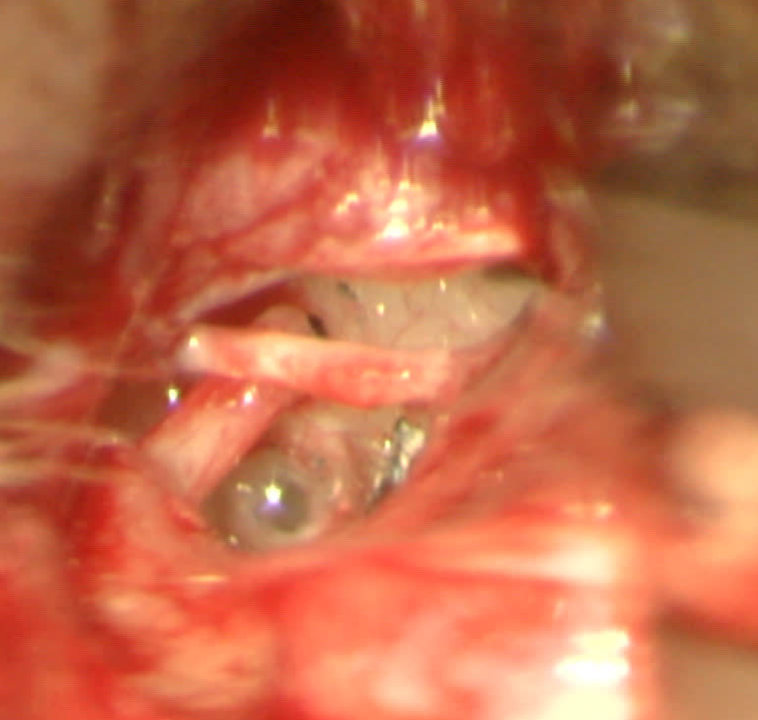Mr Fergie has performed several hundred stapes surgery cases with audited outcomes consistent with published results from other major international centres.
This surgery is performed principally for the condition of otosclerosis . Otosclerosis itself does not require management and alternative treatments to surgery are available including conventional and bone anchored hearing aids. It is not the case that surgery needs to be performed before the condition progresses and the choice to proceed with surgery is not time-limited.
The procedure itself;
How the procedure is performed varies in different centres and the description below outlines how is performed by Mr Fergie.
The surgery is performed as a day case, meaning there is no overnight stay in hospital planned.
The operation is performed under general anaesthetic and takes approximately 90 minutes to perform. A small cut (incision) is made above the natural opening of the ear canal. This is around 10mm in length in the natural groove above the ear canal and generally heals well.
A KTP laser is used to remove part of the stapes bone and a small titanium implant (Kurz-aWengen Clip prosthesis) inserted to replace the fixed stapes bone.
Post-operative period/ recovery;
Following the surgery you should not blow your nose forcibly or make any attempt to pop your ears. You should aim to sneeze with your mouth open if needed and avoid stifling sneezing. You will receive an appointment for out-patient clinic review four weeks following the operation. This is to check that the ear has healed. A hearing test will not be conducted at this stage as the hearing levels may still be changing. You should keep the inside of your ear dry until review in the out-patient clinic by placing cotton wool mixed with vaseline in the bowl part of your ear and removing after showering/bathing. You will normally be given drops to place in your ear and be instructed on their use- the packing in your ear will absorb the drops and gradually dissolve. The outside wound will heal after one week and it is recommended that it is kept dry for the first week- the sutures are dissolving and so do not need to be removed. Until review in clinic you should avoid heavy lifting, straining, heavy exercise and you should avoid dental work that involves drilling. You should not fly until first review. A second and final appointment is scheduled around 3 months after surgery when the hearing is tested to check on the outcome of the surgery.
What to expect;
It is common to experience some degree of dizziness following the operation which usually subsides quickly. You may continue to experience brief episodes of dizziness on sudden head movements, bending and straightening which gradually improves. Some slight bleeding from the ear may be encountered which usually settles in a day or two. You may also notice a slight discharge from the ear. You may experience some pain, including sharp shooting pains. You may feel pulsation, popping, clicking and a feeling of fullness as if there is liquid in your ear. At times your hearing may appear very acute only to "close over" again. A follow-up appointment is routinely given four weeks after the surgery although the full benefit of the surgery may not be evident until two to three months after the operation.
Risks of surgery
The operation is usually successful but as with all surgery, there are risks involved.
The principal risks are as follows;
Disturbance of taste involving the side of the tongue on the same side as the operated ear along with mouth dryness. These symptoms are not uncommon generally lasting a few weeks but in some cases can be prolonged
Risk of worsening hearing in the operated ear which may be severe and permanent preventing the use of a hearing aid.
Development of tinnitus or worsening of pre-existing tinnitus. Surgery usually improves tinnitus if present but there remains a risk of rather than making it better it worsens it.
Tympanic membrane perforation. Usually evident at time of surgery if occurs and repaired at the time.
Temporary weakness of the side of the face- rare and not encountered in any case performed to date
Dizziness which is usually temporary but in rare occasions may persist
At times it may not be possible to complete the operation because of specific unexpected factors encountered at time of operation
Even after successful surgery the operation may "fail" months or years later and consideration given to repeating the operation and correcting the issue if requested.
Careful consideration should be given regarding the risks of surgery before embarking on this route.
Please note that SCUBA diving is not recommended after this type of surgery and that is a permanent situation.
Fluoride therapy
This is not routinely recommended either before or after surgery but there may be specific situations where this may be considered. If you wish to discuss this treatment please feel free to do so during your appointment.
Below is information leaflet from ENT-UK for further information;





